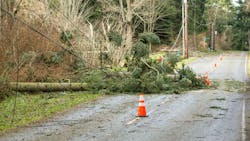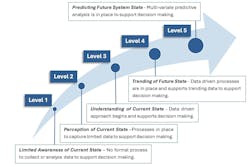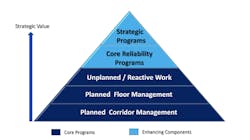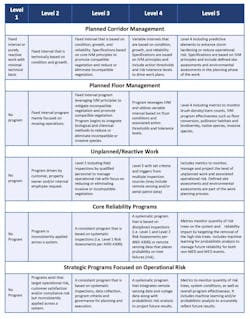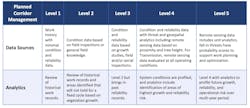Data-Driven Maturity Models Lead VM Programs to the Future
Vegetation management (VM) is crucial for electric utilities to maintain public and personnel safety and ensure grid reliability. Typically, vegetation-related outages are the leading cause of outages for electric utilities. Overgrown vegetation can interfere with power lines, leading to service interruptions, especially during storms and extreme weather conditions.
Effective VM is essential for maintaining clearances around power lines and infrastructure, reducing the risk of vegetation related outages, and ensuring compliance with regulatory requirements. It helps utilities avoid penalties and fines associated with non-compliance, while also demonstrating their commitment to regulatory standards and environmental stewardship.
Developing Vegetation Management Maturity Models
Utilities can adopt VM maturity models to optimize their operations, leverage industry best practices, ensure regulatory compliance and deliver safer and more reliable power to their customers. Maturity models provide a structured framework that utilities can use for self- benchmarking their program or benchmarking with multiple utilities to understand how their program compares with other programs in the industry.
Furthermore, maturity models can act as a roadmap where utilities can:
- Assess their current capabilities
- Identify where they want to be in their future state (two or five years later)
- Determine the capabilities they need to develop — whether associated with individual processes or cross-cutting capabilities that assist multiple processes
- Identify barriers to future success
- Develop effective business cases and strategies tailored to drive their specific operational needs
This structured approach helps utilities optimize their VM programs, drive continuous improvement and achieve their operational and regulatory objectives.
In a 2024 EPRI study called the “Vegetation Management Program Maturity Models: General Framework,” EPRI developed a general framework for vegetation management maturity models. Based on a situational awareness methodology, the maturity models outline five levels of maturity, each representing a progression in the utility’s ability to manage vegetation effectively. At Level 1, utilities have limited awareness and data of their current state, relying on traditional time-based vegetation management programs without formal processes to collect and analyze condition data. Decisions are based on past performance and legacy knowledge. As utilities progress to Level 2, they begin to perceive their current state more accurately, supported by some inspection data. Utilities can use informal processes to gather vegetation condition data, typically through field inspections, which is analyzed to determine unplanned work.
At Level 3, a transition occurs where utilities develop an understanding of their current state through a more formal data-driven approach. The program is supported by various data sources, including inspection, reliability and remote sensing data. This data-driven approach allows for variable cycles to manage the program based on operational risk and system conditions.
By Level 4, utilities are trending towards a future state with robust data analytics engines, databases and condition-based statistical analysis to support planning. All key systems are in place for data-driven decision-making.
Finally, at Level 5, utilities can predict future system states using multi-variate predictive analysis. Analytical capabilities include data-driven probabilistic analysis and/or machine learning, enabling predictive modeling of future state conditions and overall program optimization. Utilities at this level reliably optimize vegetation management goals and budgets over a multi-year horizon.
It is important to note that, although the models are structured with increasing levels of maturity to serve as roadmaps, each utility must determine the optimal maturity level based on their specific objectives, context, regulatory compliance and affordability. Most utilities operate within Levels 2 through 4, while Level 5 is intended as an ambitious target using technology and innovation. Advancing to Levels 4 or 5 may not always be cost-effective, so utilities must carefully balance the potential benefits, expected performance improvements, associated funding and overall business case before progressing to the next maturity level.
Components of the Vegetation Management Program
The vegetation management program includes multiple components, each playing a vital role in ensuring overall effectiveness. Planned Corridor Management involves tree pruning and removal of trees and/or brush within and along corridors to maintain clearances and reduce the risk of outages. Planned Floor Management includes mowing, hand cutting and/or herbicide work to manage vegetation under the lines to prevent it from interfering with power lines. Unplanned Reactive Work addresses customer or property owner requests and/or inspection-driven work by the utility to address immediate vegetation-related issues.
Core Reliability Programs focus on the targeted removal of danger/hazard trees or at-risk overhang to improve reliability and grid resiliency. Strategic Programs target operational risk, customer satisfaction and performance goals (i.e., strategic undergrounding).
Detailed Maturity Models
The high-level maturity models provide an overview of the distinct levels for each program component, offering a structured framework for utilities to assess their current practices and identify areas for improvement. The Planned Corridor Management Maturity Model details the evolution from fixed interval work to a comprehensive approach leveraging Integrated Vegetation Management (IVM) principles and predictive analytics. Similarly, the Planned Floor Management Maturity Model describes the progression from Level 1, fixed interval or purely reactive with minimal technical basis, to a data-driven approach that includes environmental and vegetation conditions for formal Integrated Vegetation Management planning.
Each maturity model is further developed by including maturity levels for the following processes: Data Sources, Analytics, Program Planning and Optimization, Work Plan Scheduling and Assignment, Work Execution and Close Out and Workflow Metrics. These processes collectively ensure that all the components of a vegetation management program are effectively managed and optimized, leading to improved reliability, reduced operational risks and enhanced compliance.
In the Planned Corridor Management Data Sources process, Level 2 data sources include data from field inspections or general knowledge based on operational experience. This operational knowledge is the key data source. Level 3 initiates the transition to a data-driven program by incorporating multiple sources of field conditions and begins to collect system reliability data based on the current state vegetation management program. Level 4 adds additional inspection processes based on empirical data via remote sensing technology that is geospatially defined and able to prioritize threats based on system conditions such as vegetation proximity to conductors and tree height. For transmission systems, the data is evaluated at all operating conditions. Level 5 considers multiple data sources including a combination of field inspections and remote sensing technologies (i.e. LiDAR, satellite or imagery) and can pre-define work units and prioritize vegetation risk to support work planning and optimization.
The Analytics process maturity progression is similar and evolves through the levels by enhancing the system risk assessment and prioritization of work. At Level 3, the analytics on the planned corridor work involves incorporating historical work records and outage data to correlate reliability outcomes based on system conditions. At Level 4, risk profiles are created using comprehensive data sources for system conditions, reliability trends and include compliance and other short-term operational risks. At Level 5, the analytics process is very robust with validated accuracy and able to profile growth, reliability and operational risk over a multi-year horizon.
In the Workflow Metrics process for Planned Corridor Management, Level 2 involves manual tracking of completion and cost and Level 3 moves the tracking to electronic format. Level 4 integrates other work management data such as QA results, completed work units and invoicing, which may or may not allow for field entry. Level 5 fully incorporates field entry by field crews to facilitate a broad range of reporting including compliance.
Data Sources Processes
In the previous vegetation management maturity models, the journey towards maturity is marked by the evolution of data sources and processes. Consequently, six data sources and processes were examined to assist utilities in advancing their programs:
- Ground Patrols
- Aerial Patrols
- Remote Sensing
- Outage Follow-up (vegetation-related)
- MED Storm Damage Assessments
- Wildfire Assessments
Although each data source process follows a distinct roadmap, several commonalities exist among them, particularly regarding data storage, accessibility and utilization. See the sidebar above for a description of the maturity progression for ground patrols as a data source.
Future Work and Enhancements
Future research should focus on developing detailed maturity models for quality control and quality assurance, refining models for regional differences and incorporating innovative technologies and system integration advancements. Furthermore, the framework must be revised periodically to incorporate advancements in data capture, processing and analysis as technology progresses.
Editor’s Note: The authors would like to recognize the following industry vegetation management leaders for their collaborative feedback to aid the development of maturity models and ensure the models were practical and relevant to the diverse needs of utilities across the country: J Bent, Duke Energy; J. Doucette, Southern California Edison; K. Patton, American Electric Power and S. Roddy, Alabama Power.
Ground Patrols: From Basic Inspections to Automated Excellence
At the initial level, utilities may lack a formal ground patrol program. Inspections, if any, are sporadic and undocumented. As utilities increase their maturity level, they begin to implement visual inspections of critical assets with general criteria to assess operational risk. Documentation of findings may still be inconsistent and not tied to a database.
Progressing in maturity, inspection criteria become clearly defined, ensuring consistency and prioritization based on operational risk. Findings are documented in a database, geospatially defined and tracked for execution. Training programs ensure that inspectors are qualified and dedicated.
At higher maturity levels, documentation of findings is entered into a work management system, allowing real-time tracking of completion. A quality control (QC) process ensures accurate reporting. Finally, as a stretch goal, automated entry of findings into the work management system is achieved. Reporting capabilities track planning and completion status, and mature quality control (QC) and quality assurance (QA) processes ensure continuous improvement.
About the Author
Ron A. Adams
Ron A. Adams ([email protected]) is currently principal owner of Right–Way Utility Solutions, LLC providing strategic advisory services on vegetation management to the electric utility industry. He has 40 years of experience in the utility industry and has held various leadership positions in vegetation management for 18 years. He earned his bachelor’s of science degree in electrical engineering and is registered as a P.E. in South Carolina.
Yamille Del Valle
Yamille Del Valle ([email protected]) is the program manager for Transmission and Distribution (T&D) Environmental Solutions, Program 51, at EPRI, which includes vegetation management and remote sensing research. As part of her work, she coordinates research efforts with numerous utilities and industry experts to develop data-driven solutions that preserve utility knowledge, aid decision processes for managers and environmental scientists, and create awareness of current technological advancements in the T&D environmental sector.
